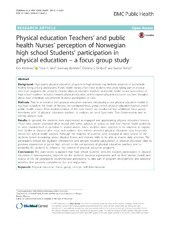| dc.description.abstract | Background: High quality physical education programs in high schools may facilitate adoption of sustainable healthy living among adolescents. Public health nurses often meet students who avoid taking part in physical education programs. We aimed to explore physical education teachers’ and public health nurses’ perceptions of high school students’ attitudes towards physical education, and to explore physical education teachers’ thoughts about how to facilitate and promote students’ participation in class. Methods: Prior to an initiative from physical education teachers, introducing a new physical education model in two high schools in the South of Norway, we conducted focus groups with 6 physical education teachers and 8 public health nurses. After implementation of the new model, we conducted two additional focus group interviews with 10 physical education teachers. In analyses we used Systematic Text Condensation and an editing analysis style. Results: In general, the students were experienced as engaged and appreciating physical education lessons. Those who seldom attended often strived with other subjects in school as well, had mental health problems, or were characterized as outsiders in several arenas. Some students were reported to be reluctant to expose their bodies in showers after class, and students who seldom attended physical education class frequently visited the school health services. Although the majority of students were engaged in class, several of the students lacked knowledge about physical fitness and motoric skills to be able to master daily activities. The participants related the students’ competence and attitude towards participation in physical education class to previous experiences in junior high school, to the competence of physical education teachers, and to possibility for students to influence the content of physical education programs. Conclusions: The participants suggested that high school students’ attitudes towards participation in physical education is heterogeneous, depends on the students’ previous experiences, and on their present health and quality of life. All participants recommended adolescents to take part in program development, and selecting activities that generate competence, fun and enjoyment. | en_US |

